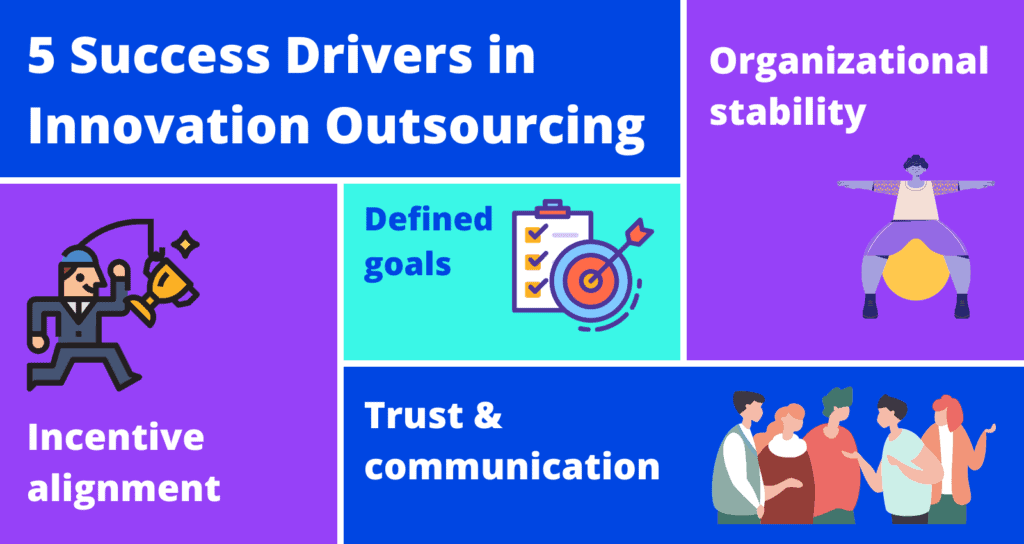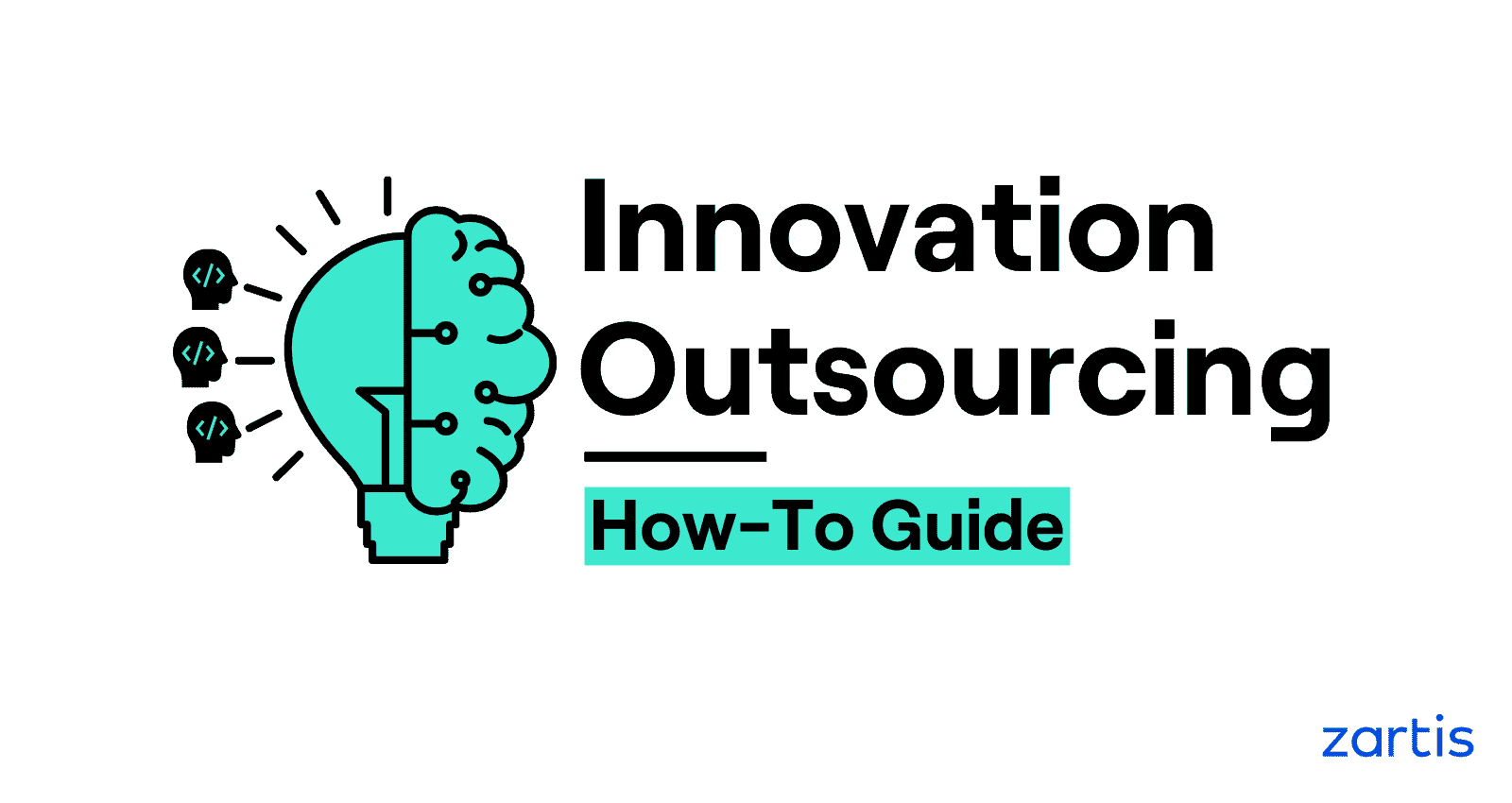The research and development (R&D) outsourcing market is looking at a compound annual growth rate (CAGR) of more than 8% by 2023. This is more than healthy progress, and for good reason. When we consider:
- The head-spinning pace of technological development
- The ever-more complex products and solutions
- The resulting need for more diverse expertise
… it comes as no surprise that a growing number of businesses are looking to outsourcing innovation management as their preferred way to develop new products.
To make innovation outsourcing work for your company, however, you need to do it right. This quick guide should give you a few helpful pointers.
What Is Innovation Outsourcing?
Innovation outsourcing is a business strategy whereby a company delegates the idea generation for new products, the development of strategies for introducing these products on the market — or both — to external service providers.
In that sense, innovation outsourcing goes beyond the contracting out of one-off projects, basic services, operations, or peripheral activities. What is being outsourced here is management, innovation, strategic research, know-how, and intellectual capital — which means the stakes are much higher.
Why do companies outsource innovation management?
The risks of innovation outsourcing may be high, but so are the potential rewards. A study by the MIT Sloan Management Review found that strategic outsourcing can help companies lower innovation costs by 60 to 90%, shorten product cycle times, and rake in ROIs of up to hundreds of times the initial investment.
Other benefits of outsourcing innovation include:
Access to Diverse Expertise and a Large Talent Pool
One of the advantages of this outsourcing model is that it allows you to team up with niche professionals. What’s more, they come with the exact industry experience, skill set, and level of expertise you need, from junior members and team leads to senior executives.
Faster Time to Market
The extra resources and hands on board can speed up the development process from an early stage, resulting in a faster time to market and giving you a considerable competitive advantage.
Scalability and Flexibility
Strategic outsourcing allows you to easily scale the external team both up and down as your project evolves. That gives you more flexibility than hiring management-level staff in-house and minimizes financial risks long-term.
The Benefits of a Mature Process
The success of any tech project, especially one focused on innovation, hinges on setting up a wide range of processes properly from the get-go. This includes not only the technical side of things (testing, DevOps, etc.) but also communications, team structure, operations, and more.
The outsourcing of innovation dispenses with the need to do all that in-house (and subject your team to a lengthy and potentially costly learning curve with an uncertain outcome). Instead, you can rely on your outsourcing partner, who has developed, tested, and approved all the processes required for delivering the exact type of product you need, as well as knowledge transfer to your in-house team if needed. For this, you would need a top rated outsourcing company, that can deliver on all fronts.
How to Make Innovation Outsourcing Work for You
Here are our six tried-and-tested tips on how to make the most of innovative outsourcing:
Step #1. Choose the Right Partner
The big risk with strategic outsourcing is that the enterprise software development companies you choose will determine to a large extent whether your project will be a success. That’s why you want to make sure your prospective partner is the right fit for your company.
Take this process seriously. Allow ample time for research, comparing different providers, and exploratory discussions with shortlisted candidates. You should be looking for a company that can deliver the level of technical expertise you are looking for and one that would also make a good cultural fit for your team.
Key things to consider at this stage include:
- The tech skills of the developers
- Whether they have access to continuous learning opportunities
- What industries and clients they work with
- Case studies on past innovation/modernization projects similar to yours
- Whether their work model is conducive to close collaboration and regular communication, which are generally required for most innovation projects
- Whether they have knowledge transfer systems in place to ensure a smooth flow of know-how to your team
The main takeaway here is this: don’t get too hung up on finding a vendor with a stellar “absolute” track record. Even the best track record only counts if it shows that the provider can meet your specific needs.
So, instead of looking at the sheer track record, look for a near-perfect “fit” or “match” based on your personal checklist: budget, industry, project type, technological expertise, collaboration model, location, etc. And always go for quality over quantity.
For more helpful tips on selecting an outsourcing vendor, check out our related blog posts:
Step #2. Make Sure Your IP Is Protected
When outsourcing idea generation, business strategy, know-how, and any other type of intellectual capital, protecting your IP rights should be your top priority. Be sure to bring the subject up in the preliminary discussions with shortlisted service providers and state it in explicit terms in all outsourcing contracts later.
Step #3. Don’t Skip on Planning Time
Did you think your work was done once you’ve chosen an outsourcing provider? We have news for you: it isn’t. The next step is to draft — very carefully — your project requirements.
This part of the process is crucial for the success of the entire operation, as it will define the product goals, performance targets, and other metrics for the road ahead. Your requirements will also set the tone for your communication and collaboration with the external teams, and that’s not something you want to start off on the wrong foot.
So, whether you plan to draft your requirements entirely in-house or with the help of an external consultant, be sure to take the time to plan and scope properly.
Your requirements and needs will likely change over time to accommodate the ever-changing market realities. However, it’s important to have the overall strategy, initial priorities, and key technologies mapped out from day one. That helps ensure smooth sailing from the start and minimizes the risk of having to tear apart and rebuild the entire product or concept further down the line.
Step #4. Create a Thorough Onboarding Program
Proper onboarding is the best way to ensure that your new team will hit the ground running. Make sure to cover not only the technical issues — goals, requirements, the technical roadmap, etc. — but also the human side of things, such as who can help new team members if they have any questions or concerns.
Step #5. Build Good Rapport with Your Outsourced Team
This 2009 study on outsourcing innovation identified five common success drivers across all provider types, namely:
- Trust
- Communication
- Defined goals
- Incentive alignment
- Organizational stability
Empirical analysis has confirmed what we at Zartis have always known to be true: setting well-defined goals, communicating them to your teams in a clear manner, and fostering an open, inclusive, and trusting work environment is a key driver for the success of any tech project.

Step #6. Ensure Knowledge Transfer
Last but not least, you want your in-house and external teams to exchange ideas and learn from each other. To make that happen, you should have appropriate channels of communication and collaboration in place. Don’t forget to also encourage the sharing of ideas and actively promote continuous learning and self-development.
Examples of Successful Innovation Outsourcing
To get a better idea of how innovation outsourcing works in real life, check out our Fexco case study.
Here’s a short teaser: in 2016, Ireland’s fintech giant hired Zartis to help it with a big legacy system modernization project. We quickly assembled a stellar extended development team who then:
- Migrated a mature application to a brand-new, cloud-based software
- Rewrote and migrated another monolithic application to the cloud
- Created a central API
- Started working on a game-changing digital signature project (ongoing)
Curious What Innovation Outsourcing Can Do for Your Business?
At Zartis, strategic outsourcing is our bread and butter.
Whether you are looking to:
- Assemble a winning extended development team
- Modernize legacy software and replace it with bespoke modern apps
- Get world-class technology consulting services
… we can help you build a successful outsourcing strategy.
Check out our scaling and modernisation services and reach out. It’s that simple.


